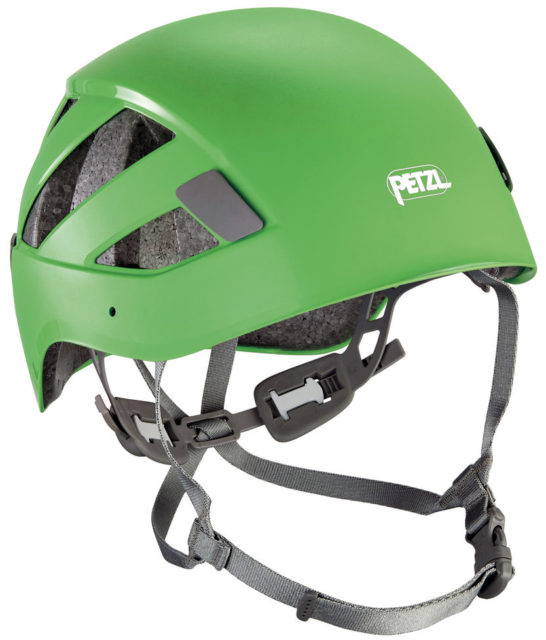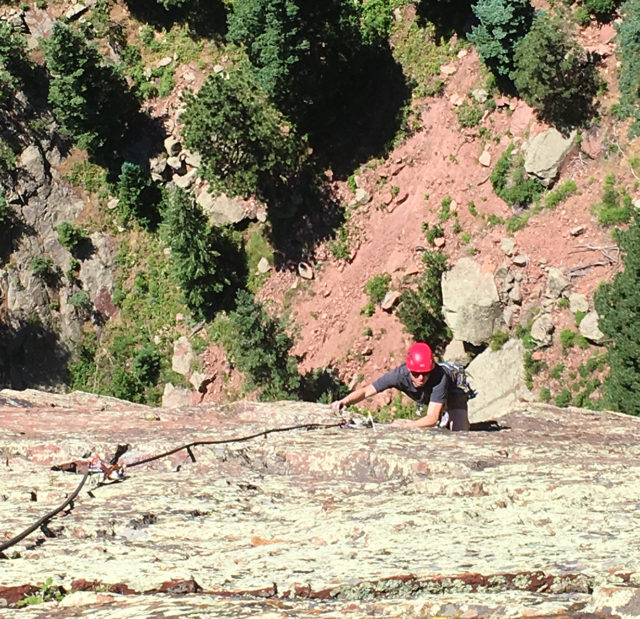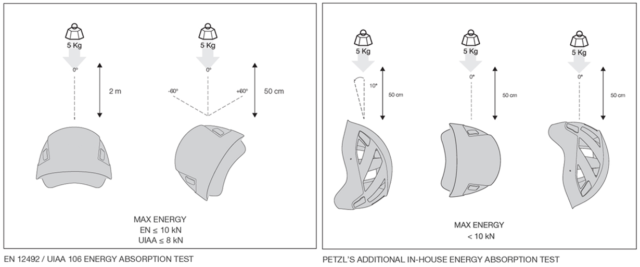
Petzl Boreo Helmet
Stated Weight (size S/M 48-58 cm): 285 grams
Blister’s Measured Weight (size S/M 48-58 cm): 300.8 grams
Stated Features:
- Hard outer shell is impact and scratch resistant for optimal durability
- Hybrid construction with thick ABS shell, an EPP foam liner and an EPS foam liner makes it compact on the head
- Soft headband conforms perfectly to the shape of the head and folds into the shell for storage and transportation
- Carries Petzl’s TOP AND SIDE PROTECTION product label
- Head-covering shape, lower in the rear, offers reinforced protection
- Four clips for headlamp attachment
- Compatible with the VIZION eye shield
MSRP: $64.95
Test Locations: Eldorado Canyon State Park, CO
Days Tested: ~10
Intro
There are a lot of good reasons to wear a helmet while climbing. Rockfall and lead falls can both be deadly — and a helmet certainly helps to mitigate those risks. However, current CE and UIAA helmet testing standards focus primarily on impacts from directly above, and don’t test as aggressively for impacts from the side and back (which are can be common during lead falls).
Petzl is attempting to address this testing-standard blindspot with their own in-house “Top and Side Protection” testing standard, which, in addition to meeting the UIAA and CE requirements, adds further tests for direct impacts from the side, front, and back of the helmet.
The new Petzl Boreo helmet carries Petzl’s Top and Side Protection label and is an affordable helmet that uses a hybrid hardshell / foam construction. So how does the Boreo perform on route, and why should someone buy it over the many other options out there?
Fit and Comfort
The Borea is available in two sizes: a S/M that’s designed to fit heads with circumferences between 48-58 cm, and a M/L that’s designed to fit heads between 53-61 cm. I tested the Boreo in the S/M size, and it fits my head well (I am usually a size Small in helmets).
Overall, the fit on the Boreo is quite easy to adjust. The helmet adjusts with a plastic ratchet system that tightens over the back of the head. There is one ratchet adjustment point on each side of the plastic cradle system. I do have to take a bit of care to ensure that both ratchets are adjusted similarly tight or else the system can get a bit skewed to one side. Helmets with a single point of adjustment (e.g., Black Diamond Half Dome) don’t have this problem.

But once properly adjusted, the Boreo is more comfortable than I expected it to be (it’s much more comfortable than the Petzl Elios). The Boreo only has thin foam pads across the forehead and the top of the head, but even without pads on the back of the helmet, the system hugs my head well and without any pressure points.
Top and Side Protection
In order to understand what Petzl’s Top and Side Protection testing adds in terms of safety, it’s important to understand the current testing standards (don’t worry, they aren’t very complicated).
The UIAA helmet test focuses mainly on penetration and impacts on the top of the helmet, which seem to correspond more to impacts from objects falling from above than they do to the lateral and rear impacts often associated with impacts from an actual fall.

During the test, the helmet is placed on a dummy simulating a human head, with a load sensor placed on the neck portion. The first aspect of the test is the top impact test, in which a 5 kg weight is dropped on the top of the helmet from a height of 2 meters. A 5 kg weight is also dropped on the helmet from a height of 50 cm with the helmet rotated 60° in the direction of the impact to perform front, side, and rear lateral-impacts tests. In all the impact tests, what is measured is not the amount of force the helmet withstands, but instead, it’s the amount of force that is channeled to the neck. For the UIAA, the force must not exceed 8 kilo-newtons, or roughly 1800 lbs of force, while the CE standard is slightly less stringent, with a max force of 10 kilo-newtons. Finally, the UIAA performs a penetration test, in which a 3 kg cone-shaped weight is dropped from a height of 1 meter on the top of the helmet in order to see if it can penetrate the helmet through to the headform. If it does penetrate through the helmet, the helmet fails the test.
In Petzl’s additional Top and Side Protection testing, a 5 kg weight is dropped from 50 cm on the side and back of the helmet at 0° and on the front of the helmet at a -10° angle (see image below). The force of these tests must not exceed 10 kilo-newtons. Petz’s impact tests are designed to simulate impacts caused from lead falls rather than just overhead rockfall.

As a likely result of meeting Petzl’s testing standards for side impacts, the Boreo offers excellent coverage around most of my head which makes for better piece of mind on the sharp end of the rope. The Borea covers more of the back and side of my head compared to the old Petzl Elios. The front of the Boreo offers especially good coverage of my forehead (and has a very small lip to help block some sun).
Features
The Boreo has a pretty standard set of features for a climbing helmet. It has four molded plastic clips on the shell to hold a headlamp which perform fine and are quite low-profile for when I’m not using a headlamp.
Although there is no adjustable ventilation on the Boreo, the helmet has large vents on the sides and back of the helmet which provide a good amount of air flow that’s noticeably better than the Half Dome.
Another useful design feature on the Borea is that its adjustment system folds into the helmet when not in use, which makes it easier to put into a pack (though sometimes I had to readjust the fit after packing the helmet because the ratchet straps can get bumped and moved).
Weight
At 300.8 grams for the size S/M, the Boreo falls in the middle of the pack compared to most other helmets. That said, it is one of the lighter hard-shell options on the market. Each helmet lighter than the Boreo on the list below is a foam or hybrid shell option, which are typically not as durable helmets like the Boreo, which features a thicker exterior ABS shell in addition to the interior foam.
For reference, here are some of the weights for several of the most popular helmets on the market. Note the size differences to try and keep things apples-to-apples.
160 g Petzl Sirocco, S/M (stated weight)
220 g Petzl Meteor, all sizes (stated weight)
234 g Mammut Wall Rider, 56-61 cm (measured weight)
248 g Black Diamond Vector, M/L (measured weight)
300.8 g Petzl Boreo, S/M (measured weight)
310 g Black Diamond Half Dome, S/M (stated weight)
330 g Petzl Panga, one-size-fits-all (stated weight)
380 g Mammut Skywalker 2, one-size-fits-all (stated weight)
Durability
The Boreo is a modern hardshell helmet designed with durability in mind. Its ABS shell can handle plenty of bumps and small impacts and the helmet doesn’t have that distinctly fragile feel that many Expanded Polystyrene (EPS) and Expanded Polypropylene (EPP) helmets do (e.g., Mammut Wall Rider and Black Diamond Vector).

However, the Boreo is still far from indestructible. It’s made with a combination of EPS and EPP foams (EPP on the very top and EPS everywhere else). Both of these foams are designed to absorb impacts by cracking and / or compressing (though EPP has a bit more give for durability on smaller impacts). For any helmet, it is essential that you inspect your helmet for damage before each use and retire it after any substantial impact (.e.g., large rockfall or an impact from a big lead fall) — even if the helmet appears to be undamaged.
After 10 days of use, the Boreo is still in great shape. I’ll update this review if I notice any durability concerns going forward.
Bottom Line
The Boreo is an affordable, comfortable, durable, helmet that offers the additional piece of mind of passing Petzl’s side protection tests in addition to UIAA and CE testing standards. It’s not the lightest option out there, but if you’re looking for an everyday helmet that offers increased protection from side, front, and rear impacts, the Boreo is definitely worth a look.
